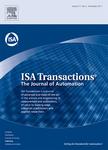版权所有:内蒙古大学图书馆 技术提供:维普资讯• 智图
内蒙古自治区呼和浩特市赛罕区大学西街235号 邮编: 010021

作者机构:NUS Joint Lab Precis Mot Syst SIMTech Singapore 117582 Singapore Singapore Inst Mfg Technol SIMTech Mechatron Grp Singapore 138634 Singapore Chinese Acad Sci Ningbo Inst Ind Technol Zhejiang Prov Key Lab Robot & Intelligent Mfg Equ Ningbo 315201 Zhejiang Peoples R China Natl Univ Singapore Dept Elect & Comp Engn Singapore 117583 Singapore
出 版 物:《ISA TRANSACTIONS》 (美国仪表、系统和自动控制协会会刊)
年 卷 期:2019年第85卷
页 面:284-292页
核心收录:
学科分类:08[工学] 080401[工学-精密仪器及机械] 0804[工学-仪器科学与技术] 0811[工学-控制科学与工程] 081102[工学-检测技术与自动化装置]
基 金:SIMTech-NUS Joint-Lab on Precision Motion Systems [U12-R-024JL] Natural Science Foundation of China (NSFC)
主 题:Data-based tuning Disturbance observer Robust control Autotuning Gradient-based optimization Vibration suppression Loop-shaping
摘 要:This work presents a new method of sensitivity shaping for motion control systems with disturbance observer (DOB). Although the traditional DOB design has been proved to be an effective means of rejecting disturbances in many applications, shaping of the closed-loop sensitivity is constrained since the Q-filter in DOB is usually restricted to a standard Butterworth or binomial form, where the cutoff frequency is the only tunable parameter. To overcome this limitation and achieve better performance for more demanding motion systems, a general form of the Q-filter is employed in this work. An data-based iteratively tuning procedure is subsequently developed according to a pre-defined cost function, so that the disturbance rejection in the low-frequency band is improved while the high-frequency noise attenuation and robust stability are not compromised. This method is data-based in the sense that the sensitivity shaping process is conducted based on the input-output data collected from the operating motion system, instead of relying on the identified system model. Simulation and experimental results are presented to show the advantage of this data-based sensitivity shaping approach. (C) 2018 ISA. Published by Elsevier Ltd. All rights reserved.